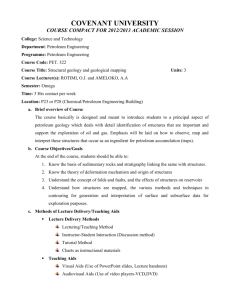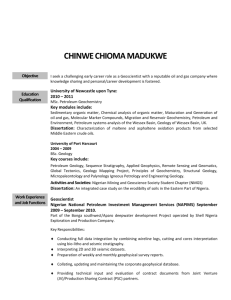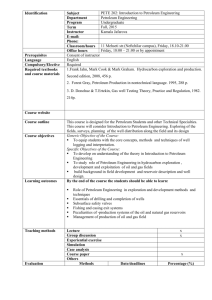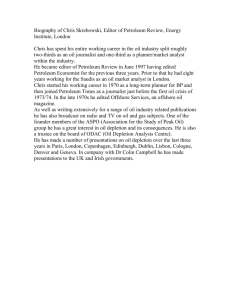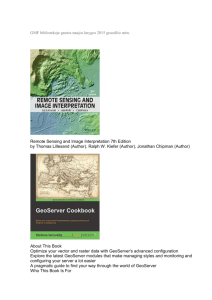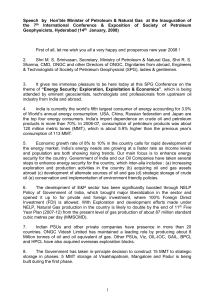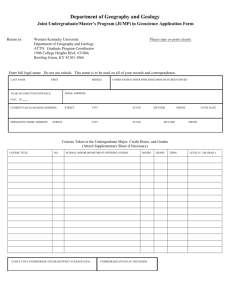GLY_511syl - University of Kentucky
advertisement
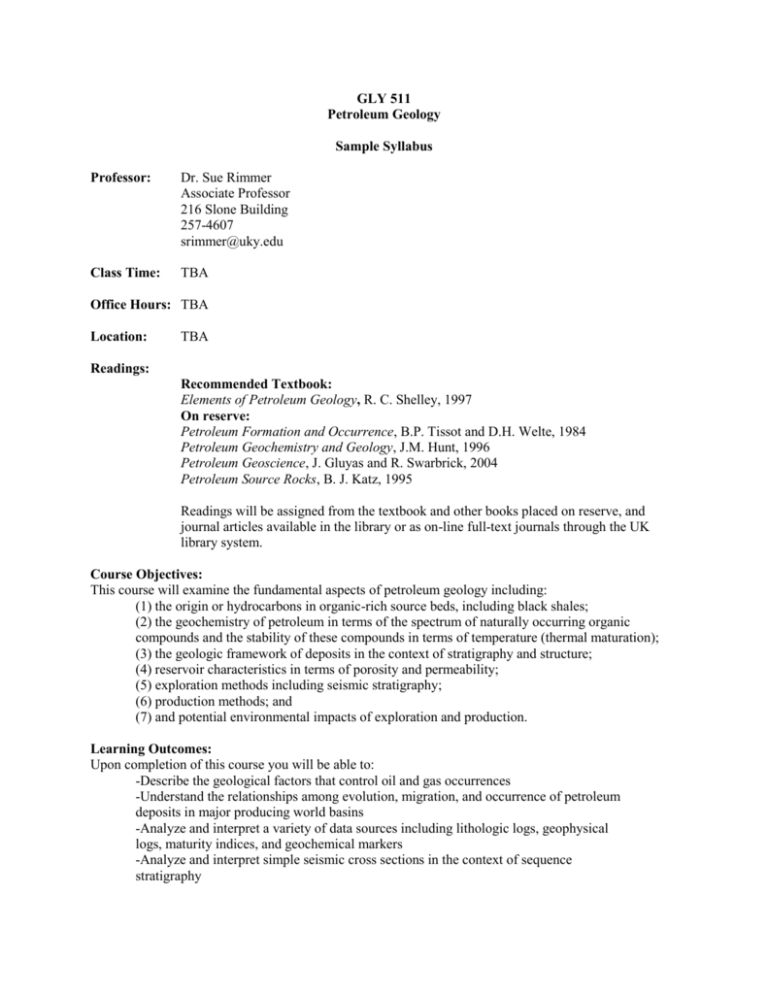
GLY 511 Petroleum Geology Sample Syllabus Professor: Dr. Sue Rimmer Associate Professor 216 Slone Building 257-4607 srimmer@uky.edu Class Time: TBA Office Hours: TBA Location: TBA Readings: Recommended Textbook: Elements of Petroleum Geology, R. C. Shelley, 1997 On reserve: Petroleum Formation and Occurrence, B.P. Tissot and D.H. Welte, 1984 Petroleum Geochemistry and Geology, J.M. Hunt, 1996 Petroleum Geoscience, J. Gluyas and R. Swarbrick, 2004 Petroleum Source Rocks, B. J. Katz, 1995 Readings will be assigned from the textbook and other books placed on reserve, and journal articles available in the library or as on-line full-text journals through the UK library system. Course Objectives: This course will examine the fundamental aspects of petroleum geology including: (1) the origin or hydrocarbons in organic-rich source beds, including black shales; (2) the geochemistry of petroleum in terms of the spectrum of naturally occurring organic compounds and the stability of these compounds in terms of temperature (thermal maturation); (3) the geologic framework of deposits in the context of stratigraphy and structure; (4) reservoir characteristics in terms of porosity and permeability; (5) exploration methods including seismic stratigraphy; (6) production methods; and (7) and potential environmental impacts of exploration and production. Learning Outcomes: Upon completion of this course you will be able to: -Describe the geological factors that control oil and gas occurrences -Understand the relationships among evolution, migration, and occurrence of petroleum deposits in major producing world basins -Analyze and interpret a variety of data sources including lithologic logs, geophysical logs, maturity indices, and geochemical markers -Analyze and interpret simple seismic cross sections in the context of sequence stratigraphy -Construct and interpret structure and stratigraphic sections for the purpose of predicting potential exploration targets -Synthesize regional and site-specific geologic constraints to propose and communicate, orally and in writing, a potential exploration target -Work and cooperate with peers on team projects Grading Policy: Differentiation of undergraduate and graduate students: Graduate and undergraduate students, as required by the university, are evaluated by different standards in all 400G- and 500-level courses. As practice in both written and oral presentations is critical at all stages of our student’s education, both undergraduate and graduate students will do both in this course, but the scope of the report will be less for the undergraduate students. Graduate student written reports must be more in depth, longer (15-20 pages), and contain more references (at least 12 primary (journal) references). By contrast, the undergraduate written reports will be 10 pages long and will include at least 6 primary references. The oral component will include a professional 10-minute presentation followed by a 5-minute question and answer period for both graduate and undergraduate students, but the weighting in the overall grade will be different, reflecting the fact that for many undergraduates this could be one of their first presentations. There will also be an extra question on each exam for the graduate students (one that may be attempted by undergraduates for extra credit). The grade for the course will be computed from the following components and their respective weights: Graduate Students: Exam 1 Exam 2 Assignments Written Report Oral Report Final Exam 20% 20% 15% 15% 10% 20% Undergraduate Students: Exam 1 Exam 2 Assignments Written Report Oral Report Final Exam 25% 25% 10% 10% 5% 25% Letter grades will be assigned based on the final computed grade as follows: > 90% A 80-89% B 70-79% C 60-69% D < 60% E Field Trips: There will be two required field trips in this course. The first will be to examine core at the Kentucky Geological Survey core facility, the second will be to an active drill site and producing field in the Appalachian Basin. Assignments: Unless otherwise stated, assignments are due at the beginning of the class period one week following the class period that the homework is assigned. Assignments will consist of analytical problem solving, running simple burial models, and reports (oral and written); the latter will include summaries of articles from the literature, mostly dealing with seminal papers in the field and case studies. This course will involve numerous team exercises, including projects (such as proposing an oil or gas ‘play’ or basin evaluations) with in-class presentations and peer review and I encourage a "team" approach to learning. However, work that is submitted must be your own work, and all sources cited appropriately. Exams: Exams will be short answer/essay format, and will include questions from the entire range of topics covered. Exams will be prepared using questions from the primary instructor as well as those suggested by “module” instructors. One question on each exam will be primarily for graduate students, but may attempted by undergraduates for “extra credit”. Presentations and Reports: Each student will give a 10-minute presentation on a topic to be assigned, followed by a question period, following the format of professional meetings in our field (for example, annual meetings of the Geological Society of America). Students will use Powerpoint in their presentations, and attention will be given to clarity and format of the slides, as well as content and presentation style. Feedback will be provided by the class (using feed-back cards) as well as by the instructor, emphasizing “good areas” and “areas for improvement” as well as assigning individual grades to each presentation. Students will also hand out paper copies of their slides (6 per page) to each student. Grades for the presentation will be based on instructor assessment in conjunction with peer review (student assessment). Previous use of this format has shown that students truly benefit from such “peer review,” find this less intimidating than simple instructor evaluation, and helps build camaraderie in the group. One week after the presentations, the written report will be due (Dates TBA). Papers must be typed, 1.5 spacing, and be appropriately referenced. Details on the format will be discussed in class. Graduate student written reports will be 15-20 pages and contain more references (at least 12 primary (journal) references); undergraduate written reports will be 10 pages long and will include at least 6 primary references. Course Outline: I. Introduction and History of Petroleum Industry II. Geochemistry, Origin, and Evolution of Petroleum -Source Beds -Chemical Composition of Petroleum -Thermal Maturation of Hydrocarbons III. Occurrence of Petroleum: Reservoirs -Porosity -Permeability -Siliciclastic vs. Carbonate Reservoirs -Primary and Secondary Migration -Burial History and Diagenesis -Case Studies IV. Occurrence of Petroleum: Structure and Stratigraphy -Types of Traps: Structural, stratigraphic, and combinations -Trap Sealing -Basin Analysis -North American and World Basins: Case Studies V. Exploration Methods -Reflection and Refraction Seismology -Sequence Stratigraphy -Borehole Geophysical Methods and Lithologic Properties -Core Analysis VI. Production Methods -Drilling; vertical and horizontal -Well completion -Reservoir Enhancement -Secondary Recovery Techniques VII. Environmental Impacts -Toxicology of Petroleum -Site-Specific Impacts -Transportation Impacts -Greenhouse Gases -Geochemical Constraints on Climate Change
